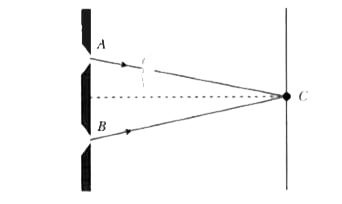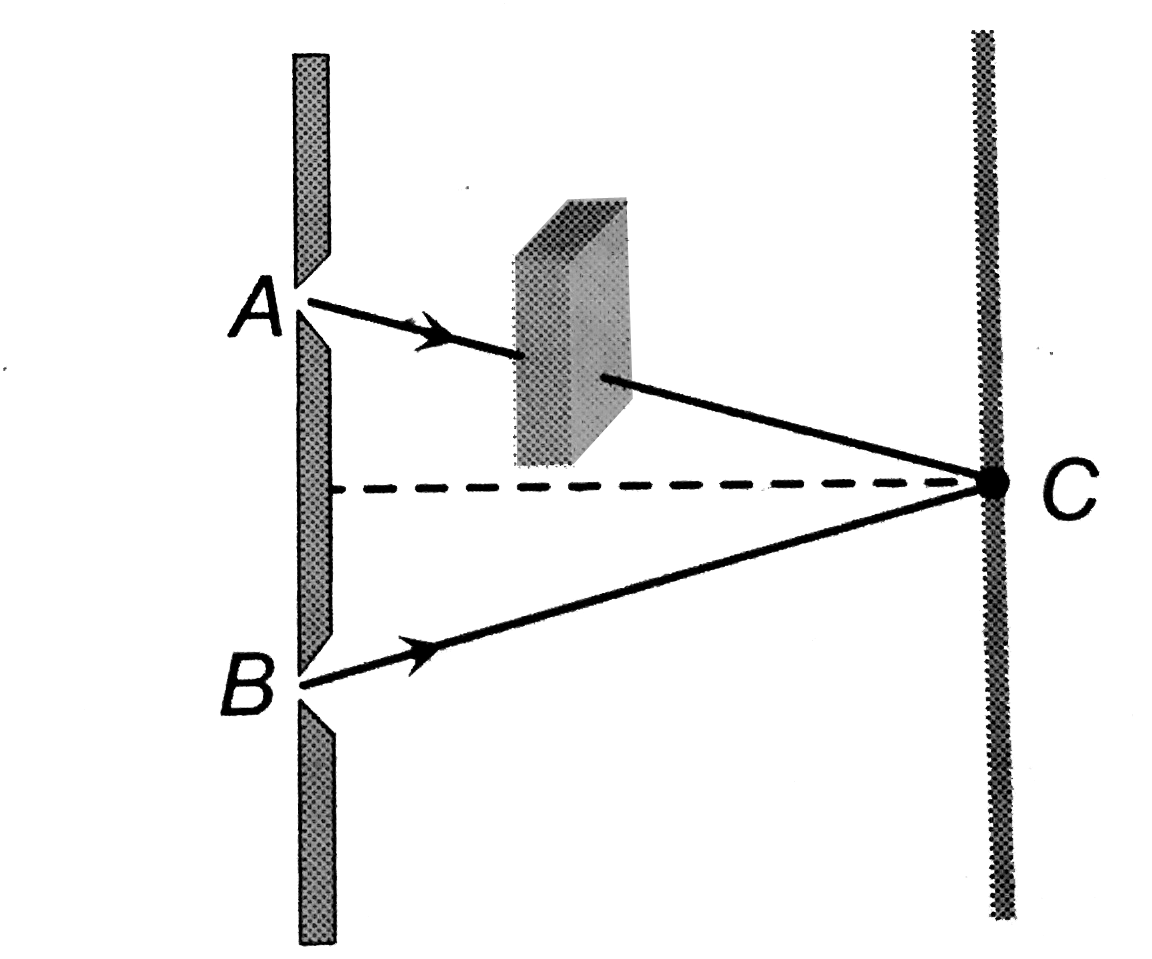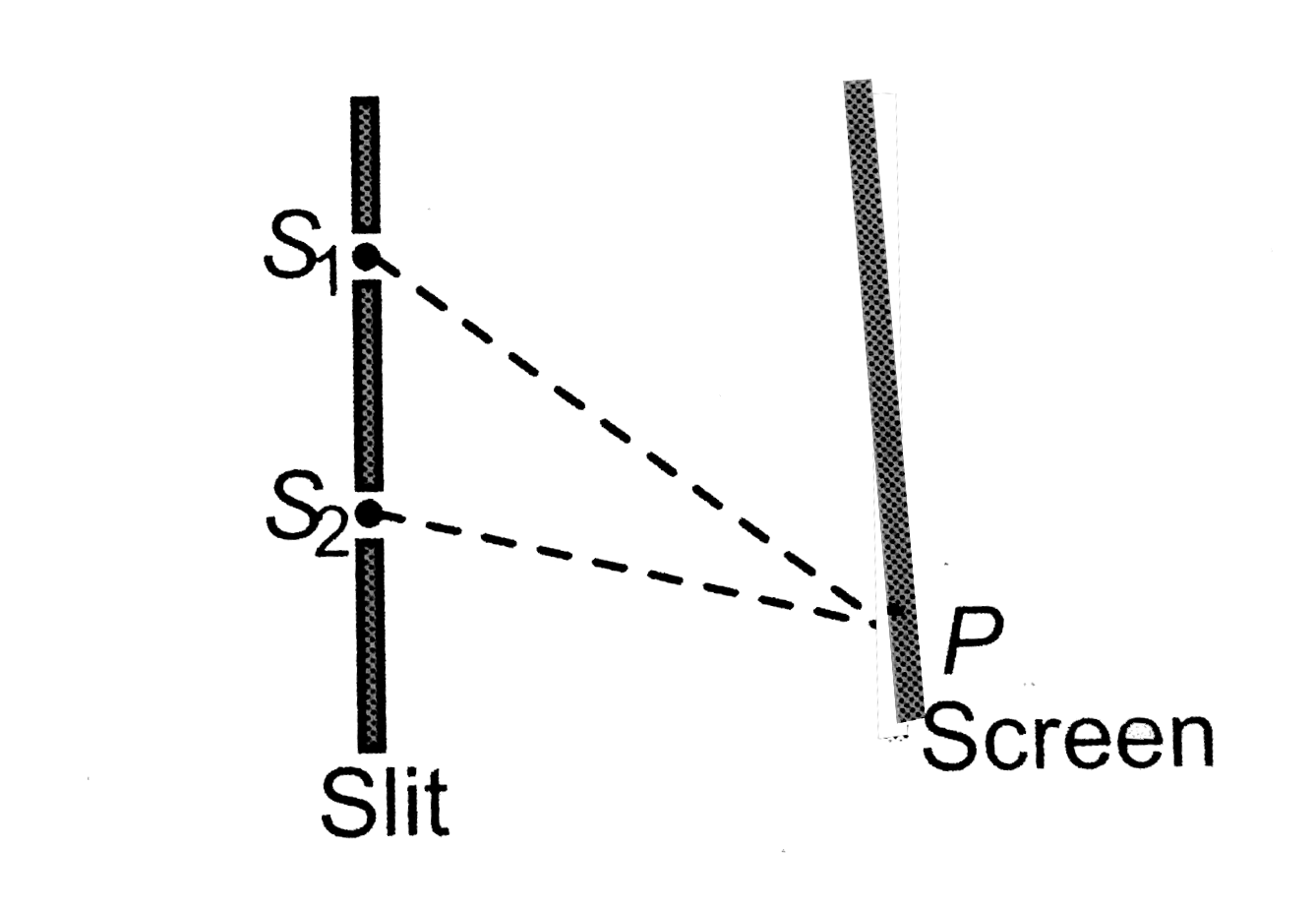In Young’s experiment, monochromatic light through a single slit S is used to illuminate the two slits S1and S2. Interference fringes are obtained on a screen. The fringe width is found to be w. Now a thin sheet of mica (thickness t and refractive index μ) is placed near and in front of one of the two slits. Now the fringe width is found to be w’, then :
w'=w/μ
w'=wμ
w'=(μ−1)tw
w'=w
The correct Answer is:D
To solve the problem, we need to analyze the effect of placing a thin mica sheet in front of one of the slits in Young's double-slit experiment. We will derive the relationship between the original fringe width w and the new fringe width w′ after inserting the mica sheet.
1. Understanding the Original Fringe Width:
The fringe width w in Young's double-slit experiment is given by the formula:
w=λDd
where:
- λ = wavelength of the light used,
- D = distance from the slits to the screen,
- d = distance between the two slits.
2. Introducing the Mica Sheet:
When a thin sheet of mica of thickness t and refractive index μ is placed in front of one of the slits (let's say slit S1), it introduces an additional optical path difference due to the change in speed of light in the mica.
3. Calculating the Extra Path Difference:
The extra path difference Δx′ introduced by the mica sheet can be calculated as:
Δx′=(μ−1)t
This is because light travels slower in the mica than in air, leading to a longer effective path.
4. Total Path Difference:
The total path difference Δx for constructive interference at the position of the bright fringe will now be:
Δx=Δx−Δx′=Δx−(μ−1)t
For constructive interference, this path difference must be equal to nλ (where n is an integer).
5. Finding the New Fringe Position:
The position of the bright fringe on the screen is given by:
yn=nλDd+(additional term due to mica)
The additional term due to the mica will be (μ−1)tDd.
6. Calculating New Fringe Width:
The new fringe width w′ can be derived from the difference in positions of two consecutive bright fringes (for n and n+1):
w′=yn+1−yn=((n+1)λDd+(μ−1)tDd)−(nλDd+(μ−1)tDd)
Simplifying this gives:
w′=λDd
This shows that the additional term cancels out, and thus:
w′=w
Conclusion:
The new fringe width w′ remains equal to the original fringe width w even after placing the mica sheet in front of one of the slits.
The fringe width w in Young's double-slit experiment is given by the formula:
w=λDd
where:
- λ = wavelength of the light used,
- D = distance from the slits to the screen,
- d = distance between the two slits.
When a thin sheet of mica of thickness t and refractive index μ is placed in front of one of the slits (let's say slit S1), it introduces an additional optical path difference due to the change in speed of light in the mica.
The extra path difference Δx′ introduced by the mica sheet can be calculated as:
Δx′=(μ−1)t
This is because light travels slower in the mica than in air, leading to a longer effective path.
The total path difference Δx for constructive interference at the position of the bright fringe will now be:
Δx=Δx−Δx′=Δx−(μ−1)t
For constructive interference, this path difference must be equal to nλ (where n is an integer).
The position of the bright fringe on the screen is given by:
yn=nλDd+(additional term due to mica)
The additional term due to the mica will be (μ−1)tDd.
The new fringe width w′ can be derived from the difference in positions of two consecutive bright fringes (for n and n+1):
w′=yn+1−yn=((n+1)λDd+(μ−1)tDd)−(nλDd+(μ−1)tDd)
Simplifying this gives:
w′=λDd
This shows that the additional term cancels out, and thus:
w′=w
The new fringe width w′ remains equal to the original fringe width w even after placing the mica sheet in front of one of the slits.
Similar Questions
In Young's double slit experiment , red light of wavelength 620 nm is used and the two slits are 0.3 mm apart . Interference fringes are observed on a screen 1.3 mm apart . Calculate (i) the distance of slits from the screen and (ii) the fringe width if this distance is doubled .
View SolutionIn Young's double-slit experiment, let A and B be the two slit. A thin film of thickness t and refractive index μ is placed in front of A. Let β= fringe width. Then the central maxima will shift
View Solution
Knowledge Check
In Young's experiment, monochromatic light is used to illuminate the two slits A and B. Interference fringes are observed on a screen placed in front of the slits. Now, if a thin glass plate is placed normally in the path of the beam coming from the slit, then
 AThe fringes will disappearBThe fringe width will increaseCThe fringe width will decreaseDThere will be no change in the fringe width, but the pattern shifts
AThe fringes will disappearBThe fringe width will increaseCThe fringe width will decreaseDThere will be no change in the fringe width, but the pattern shiftsIn Young's experiment, monochromatic light is used to illuminate the two slits A and B. Interference fringes are observed on a screen placed in front of the slits. Now if a thin glass plate is placed normally in the path of the beam coming from the slit
 A(a) The fringes will disappearB(b) The fringe width will increaseC(c) The fringe width will increaseD(d) There will be no change in the fringe width but the pattern shifts
A(a) The fringes will disappearB(b) The fringe width will increaseC(c) The fringe width will increaseD(d) There will be no change in the fringe width but the pattern shiftsIn a Young's double slit experimental arrangement shown here, if a mica sheet of thickness t and refractive indec μ is placed in front of the slit S1, then the path difference (S1P−S2P) is
 A(a) Decreases by (μ−1)tB(b) Increases by (μ−1)tC(c) Does not changeD(d) Increases by μt
A(a) Decreases by (μ−1)tB(b) Increases by (μ−1)tC(c) Does not changeD(d) Increases by μt
In a young's double slit experiment ,let Aand B be the two slits.A thin film film of thickness t and refractive indexμ is pklaced in front of A.Let β =fringe width.The central maximum will shift:
View SolutionIn the Young’s double slit experiment, for which colour the fringe width is least
View SolutionA thin transparent sheet is placed in front of a slit in Young's double slit experiment. The fringe width will
View SolutionIn the Young's double slit experiment , a mica slip of thickness t and refractive index μ is introduced in the ray from first source S1 . By how much distance fringes pattern will be displaced ? (d = distance between the slits and D is the distance between slits and screen)
View SolutionUsing monochromatic light of wavelength λ in Young's double slit experiment, the eleventh dark fringe is obtained on the screen for a phase difference of _____.
View Solution
